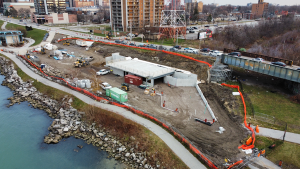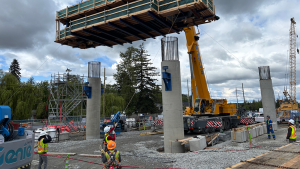After years of planning, Spaceport Nova Scotia finally has construction lift-off.
Heavy equipment has been brought in to construct roads at the site of the spaceport being built on 335 acres near the communities of Canso, Little Dover and Hazel Hill at the northeastern tip of Nova Scotia’s mainland.
The venue was recently given the green light to proceed after Maritime Launch Services satisfied all the conditions under an environmental assessment. Geotechnical exploratory work has been completed and formal construction is beginning on the site and roads.
“Staff are out there and we are working on the roads to get us out to the launch pad location,” says Maritime Launch president and CEO Stephen Matier.
The site will be the first commercial orbital launch complex in Canada and the country’s fifth satellite launch site. Structures to be built include a mission integration facility and launch pad, and associated elements.
“The structures will be quite significant when they’re done,” says Matier. “We’ve got to get the initial roadways in and there’s a tiny stream where we have to put a formal crossing over. It’s not just a logging road, it will be a full-access road and it’s a couple of kilometres long in total that goes to the mission integration facility which is where the high-bay, payload processing facility will be, and then down to the launch pad itself and all the things that go with the launch pad. That roadwork is just getting underway.
“We’ll get as far as we can this season. We had hoped to start this construction phase at the beginning of the year, or much earlier this year, but we’ll take it as far as we can and start the major construction activities next year.”
The launch facility is being built on Crown land in accordance with a 20-year lease, which includes an option for a 20-year renewal based on compliance with terms and conditions.
When a satellite is ready, it will be taken via a transporter to the launch pad, which will be a standard pad with a flame trench and erector for the vehicle, and storage area for liquid oxygen, helium and nitrogen.
Trades that work on the project will be very much the same as would be required of those that build a liquefied natural gas plant.
Matier says with geotechnical exploratory work completed, the team can now focus on launching the actual build. The exploratory work was necessary to determine how much overburden covers the granite rock so crews know where to cut and fill and also, from a foundational perspective, where buildings should be erected.
“We’ve got the launch pad, the mission integration facility, the piece that’s remaining is, we’ve got to do a couple of test wells for water-siting as we don’t want to try to bring in water from the town of Canso.”
The construction start has been a long time coming. The environmental assessment was approved in 2019 with a list of conditions that had to be met before building could begin. Maritime Launch worked closely with NavCanada, Transport Canada and Indigenous communities in the area that have embraced the project.
The spaceport will provide satellite delivery services to clients in support of the growing commercial space transportation industry over a wide range of inclinations. The development of the facility will allow for medium-class launch vehicles to place their satellites into low-earth orbit.
“People have gone away from the massive satellites and they are going into geosynchronous orbits,” explains Matier.
“Now they’re building these 100-, 200-, 300-kilogram satellites by the dozens or hundreds that are what are called constellations. They don’t go into a geo-orbit, they go into more polar orbits and inclinations that are often polar by a few degrees.”
With the development of Spaceport Nova Scotia, Maritime Launch expects other national and international space companies will choose to establish a corporate presence in the province to be near the commercial launch site.
Nova Scotia was chosen for the site because it is convenient for clients to get to and is in a prime spot for launches.
“It’s really about orbital mechanics and where the satellites go, and where they want them to go,” says Matier. “That range of inclinations will be significantly larger than any other place available in North America in one place. You can’t get the kind of range that we offer in one spot. That’s why you can’t just build a spaceport anywhere on Earth and have it be viable.”
In the first half of 2023, Maritime Launch is aiming for the sub-orbital launch of a small rocket called Aurora, with Quebec-based Reaction Dynamics, and will be working with the government on the regulatory framework.
In the second half of 2023, the team will gear up for an orbital launch with a larger rocket, the Cyclone-4M.
The plan is to launch the rocket up to eight times a year from Spaceport Nova Scotia.











Recent Comments
comments for this post are closed